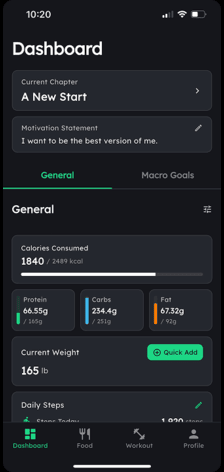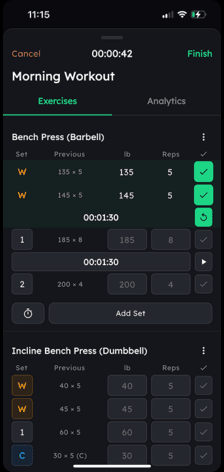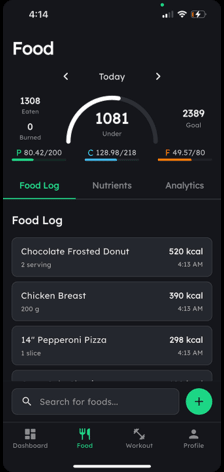Why Counting Calories Feels Like a Full-Time Job
You decided to get serious about your fitness. The first piece of advice you heard was to count calories. So you downloaded an app, bought a food scale, and started logging everything. For the first week, you felt in control. You hit your numbers perfectly. But then, life happened.
A dinner out with friends. A busy day at work. You started estimating instead of weighing. Soon, you were missing entire meals, then entire days. The process felt tedious and restrictive. It turned food into numbers and eating into a chore. After a few weeks, you stopped altogether, feeling like you failed.
This is the most common pattern we see. The problem is not your willpower. The problem is the approach. The conventional wisdom on how to count calories sets you up for failure from day one. The secret isn't to track harder, but to track smarter. What if the goal wasn't perfection, but consistency?
Why a 'Perfect' Calorie Goal Is a Trap
The biggest mistake people make is starting with an aggressive calorie deficit. You've probably heard the rule of thumb to cut 500 calories per day to lose one pound per week. While the math is correct, the psychological and physiological reality is not. This sudden drop in energy intake is a shock to your system.
Starting with a huge 500-calorie deficit is the fastest way to fail. Your body responds with intense hunger signals, powerful cravings, and decreased energy. You're fighting a battle against your own biology that you will eventually lose. Instead of creating a sustainable habit, you create a cycle of restriction and rebound. The goal is not to see how much you can suffer. The goal is to create a small, manageable change that you can stick with long enough to see results.
The counterintuitive solution is to first figure out how much you need to maintain your current weight. You need a baseline. Once you establish what your body is used to, you can make a small, strategic reduction that doesn't trigger a massive internal alarm. Here's exactly how to do it.
The 3-Step System for Calorie Control That Lasts
This method focuses on building a sustainable habit, not chasing a perfect number on a calculator. It requires patience for the first two weeks, but it builds a foundation that prevents the typical burnout and failure.
Step 1. Find Your Baseline (Maintenance Calories)
Before you can cut, you need to know your starting point. For two weeks, your only goal is to eat a consistent number of calories and track your weight. A simple formula to estimate your maintenance calories is to multiply your bodyweight in pounds by 14-16. For most people, 15 is a good starting point.
For example, a 180 lb person would start with a target of 180 x 15 = 2700 calories per day. Eat this amount every day for two weeks. If your weight stays relatively stable, you've found your maintenance. If it goes up, reduce by 100-200. If it goes down, increase by 100-200. The goal is to find the number that keeps your weight the same.
Step 2. Make a Small, Sustainable Cut
Once you have your true maintenance number from Step 1, it's time to create a deficit. But instead of a drastic 500-calorie cut, you will only subtract 200-300 calories. Using our example, the 180 lb person with a 2700 calorie maintenance would now aim for 2400-2500 calories per day.
This smaller deficit is the key. It's large enough to stimulate fat loss but small enough that it doesn't trigger extreme hunger or energy crashes. You'll feel normal, which makes it possible to stick to the plan for months, not just days. This is how you achieve lasting results.
Step 3. Track Consistently, Not Perfectly
The final step is to make tracking as easy as possible. The biggest reason people quit tracking isn't the work-it's losing sight of why they started and the friction of the process itself. You can track with a simple notebook or a spreadsheet. However, looking up nutrition information for every single ingredient can take 5-10 minutes per meal. That adds up quickly.
This is where technology can remove friction. An app with a robust food database makes the process much faster. Mofilo's food tracker uses barcode, photo, and label scanning to log a meal in under 30 seconds, using a database of over 2.8 million foods. It also keeps you connected to your goal by showing you your personal 'why' every time you open the app. Before you log a single item, you are reminded of the reason you started, which is the ultimate fuel for consistency.
What Happens When You Stop Chasing Perfection
When you adopt this three-step method, your relationship with food and tracking changes. You stop seeing it as a pass or fail test each day. Instead, it becomes a simple tool for awareness and guidance. The small, sustainable deficit means you have energy for your workouts and your life. You are not constantly battling cravings.
Because the process is less demanding, you stick with it. Weeks turn into months. The scale starts moving down slowly but consistently. You are building a system for long-term health, not just a temporary diet. You finally break the cycle of starting and stopping, and you begin to see the permanent changes you were looking for all along.
Frequently Asked Questions
How accurate does calorie counting need to be?
Consistency is more important than perfect accuracy. Aim to be within 100 calories of your daily target. The goal is to maintain a consistent deficit over time, not to hit an exact number every single day.
Should I count calories on weekends?
Yes, but you can use a weekly average. If your daily target is 2400, your weekly target is 16,800. This allows you to eat a bit more on a weekend day as long as you balance it out on other days.
What if I go over my calorie goal?
Do not try to compensate by starving yourself the next day. This creates a bad cycle. Simply accept it and get back on track with your next meal. One day does not ruin your progress.
All content and media on Mofilo is created and published for informational purposes only. It is not intended to be used as a substitute for medical advice or treatment. Users should always consult with a doctor or other healthcare professional for medical advice. If you have or think you are at risk of developing an eating disorder, do not use the Mofilo app and seek immediate medical help.





